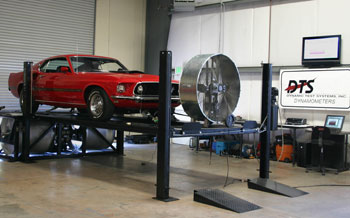
By Harold Bettes
Dynamometers have been around for ages. Well, almost. Dyno testing didn’t really get off the mark for serious use until James Watt (January 19, 1736 – August, 25, 1819) decided that horsepower was something to call the power equivalent to horseflesh that was doing the heavy lifting of the day (1780).
The first real reference to brake horsepower (as in dyno testing) wasn’t used until about 1822 and the horsepower game hasn’t been the same ever since. Dynos have been part of the more serious scene for engine builders, racers and engineering groups in the U.S. since about the early to mid-1950s.
Because of the many assumptions of what a dyno can do for you, perhaps it is timely to look more closely at how you should think about dynos as a potential part of being an engine builder.
Did You Know…
The word dynamometer is defined in the dictionary as: Dynamometer (Dy-Na-mom-e-ter) – any number of devices for force measurement or measurement of mechanical power. The word comes from the Greek (dunamis – force) + (metron – measurement) and dynamometers might seem more like Greek than anything else until you learn a little something about them.
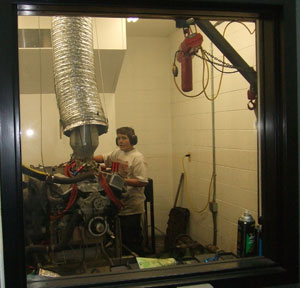 What’s In It For You
What’s In It For You
If you want to improve your engine building talents or to develop a better engine combination for an engine that you own, a dynamometer testing program could help you achieve that goal. And, if you are into racing or work at a shop that builds racing and performance engines, tagging along with a shop’s dyno team is a great way to gain additional experience.
You may be lucky enough to get to use one at the shop where you eventually land a job, or you boss may have to rent dyno time to achieve these goals. Or, if you attend a school that has dyno equipment — you’re already ahead of the curve.
Dyno Costs
First of all, none of the devices are inexpensive. The facilities to support them are not cheap. Adequate support personnel are not cheap, either. So if you are looking for a cheap solution to your engine testing needs, the best solution would be to align yourself with a shop that rents dyno time.
Next, you’ll need to understand the principal differences between engine and chassis dynos. The most common type of dyno that folks think about (if they build engines) is an engine dyno.
Engine dynos today generally cost from a low of $30,000 to about $70,000, while the typical engine dyno testing charges from across the country vary from $500 per day to about $1,000 per day, depending on the level of support that is supplied. You can learn a lot about a given engine combination in a day if you plan your testing, tuning and parts swapping carefully.
The typical chassis dyno testing charges vary from $30 to $50 per pull to about $200 for a “tuning” session of two hours or so. Labor charges are all over the map and depend on what type of testing is done and what level of tuning support is offered.
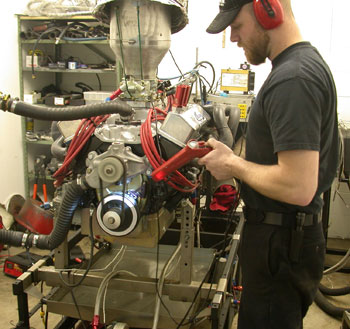 Remember — If your employer is paying that kind of money to have engines tested, you’ll need to make sure you have a grasp of the dyno fundamentals so you are not costing the shop money. One of the best ways to save if paying by the hour is to show up prepared.
Remember — If your employer is paying that kind of money to have engines tested, you’ll need to make sure you have a grasp of the dyno fundamentals so you are not costing the shop money. One of the best ways to save if paying by the hour is to show up prepared.
Planning a Dyno Test
Go with a plan, because wishes won’t work when it comes to testing.
Be aware of one thing when you are renting a testing facility or service. You are the boss! Taking suggestions so that your planning is adequate is good, but it is you who is the customer. Because you (or your employer) are going to be paying for the test, try and get the most out of the time and dollars expended.
Talk with the test facility staff before you go to the test session. That way they can help you plan more effectively, find out what parts they expect you to bring to the test session. For example — Bell housing? Headers? Your own shop rags or paper towels? Know before you go.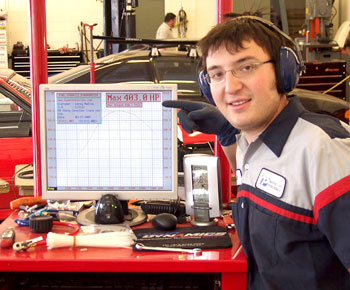
Also, say you have a flat tappet camshaft in the engine. What do they recommend for a break-in procedure? Do the soft springs need to be changed after break-in? Different rocker ratios after break-in? Remember that you also might be required to re-torque the heads after the cam break-in.
So make a list. The list helps make up the plan. Don’t go into a dyno test session with three carburetors, five manifolds, three camshafts and two separate ignition systems and expect to get it all done in one day on the dyno. Be realistic and be methodical. Be very rigid about keeping notes and work at creating good documentation of your testing experiences. This process alone (if done well) will help move your racing program forward.
Misconceptions Lead to Miscalculations: One of the more common misconceptions about a dynamometer is that it measures horsepower. WRONG – it only measures TORQUE and RPM…horsepower must be calculated.
The math is fairly simple: torque times engine rpm divided by 5252 equals horsepower.
Get You Goals and Objectives Down
Part of the plan should outline what you want to test and what specific parts you want to test. Sequences are important so that you can get the best bang for your buck. Most testing services start charging and the clock begins when you and your engine or chassis are on site.
If you require a particular fuel, you had better have enough for the tests or you will be paying for down time while waiting on more fuel. The same goes for specific lubricants. If you intend to break-in the camshaft and then change oil, as is the common practice, then you had better have your brand with you. If you don’t, you are still on the test facility’s clock while someone goes for the items that you forgot.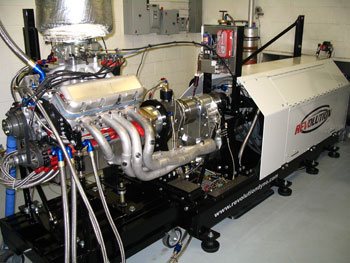
Plan on trying to keep the water temperature, oil temperature and the A/F ratio as controlled as possible.
If testing on a chassis dyno, the temperature of the bearings on the dyno, the temperature of the transmission and the temperature of the drive axle should be controlled to as much as possible. Even the inflation pressure and the temperature of the drive tires are important variables to control if dependable results are the goal. Note that it is a lot easier to write this stuff than it is to actually do it. Put some time in creating a plan that will help you keep focused on the real target of the testing session, which is to gain more useful data to convert to meaningful information. Test first and analyze later.
Comparing Dyno Numbers
Numbers only mean something if you know where the numbers come from.
Believe it or not, it can be done. It is actually pretty easy to compare dyno numbers from different facilities if the numbers and arithmetic are done correctly AND if the equipment is properly calibrated. You know how it is when various folks try to compare the dimensions on a block or a crankshaft or any other engine component. It depends on the skill of the operator and on the calibration of the measuring equipment. If you have ever tried to explain that to someone, then you have a small taste of the problem with different dyno numbers.
The space allotted here is not nearly enough to address all the details of either dynos or dyno testing, but hopefully you now have a little better understanding of at least some of the things to consider.
However, to get really accurate dyno numbers, tests need to be done under carefully controlled conditions. If you’re conservative, you’ll do a series of three to five runs and then average the numbers to get relatively accurate torque and horsepower figures. But, if you just want the biggest numbers, you’ll do a series of runs and pick the one that generates the best results and toss the rest.
Harold Bettes is a dynamometer and flowbench test equipment consultant with more than 35 years of experience in working with these test devices. His private phone number is in many major racing team engineers’ pockets for consulting reference. His company – Power Technology Consultants – can be reached at
www.powertechnologyconsultants.com.





